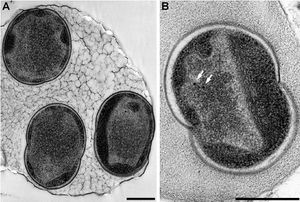Candidatus Scalindua: Difference between revisions
| Line 16: | Line 16: | ||
=Description= | =Description= | ||
The “Candidatus Scalindua” group is primarily found in marine environments. | Anaerobic ammonium-oxidizing (anammox) bacteria can use nitrite and ammonia are the last major | ||
addition to the nitrogen-cycle (N-cycle). | |||
while only a few | The “Candidatus Scalindua” group is primarily found in marine environments. It contains taxonomically diverse members, | ||
have been successfully grown in enrichment cultures | while only a few them have been successfully grown in enrichment cultures. | ||
[[File:alcanivorax bork.jpg|300px|thumb|right|Alcanivorax borkumensis [1F] ]] | [[File:alcanivorax bork.jpg|300px|thumb|right|Alcanivorax borkumensis [1F] ]] | ||
Revision as of 15:56, 13 May 2015
Classification
Domain: Bacteria
Phylum: Planctomycetes
Class: Planctomycetacia
Order: Planctomycetales Family: Brocadiaceae
Genus: Scalindua
Species: Candidatus Scalindua
Description
Anaerobic ammonium-oxidizing (anammox) bacteria can use nitrite and ammonia are the last major addition to the nitrogen-cycle (N-cycle). The “Candidatus Scalindua” group is primarily found in marine environments. It contains taxonomically diverse members, while only a few them have been successfully grown in enrichment cultures.
Ecology and Significance
Genome Structure
Metabolism
References
[1] Golyshin, Peter N. “Genome Sequence Completed of Alcanivorax borkumensis, a Hydrocarbon-degrading Bacterium That Plays a Global Role in Oil Removal from Marine Systems.” 3 (2003): 215-20. Print.
Figures
[1F]
[1] [2F] [2] [3F] [3] [4F] [4] [5F] [Original Figure. Author: Pawan Dhaliwal] [6F]
http://microbewiki.kenyon.edu/index.php/File:Lorenzo.gif
[7F] [5]
Author
Page authored by Minghung Hsu, student of Prof. Katherine Mcmahon at University of Wisconsin - Madison.

